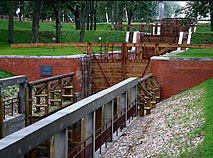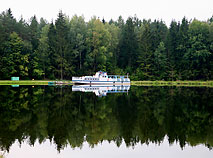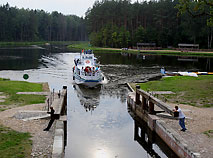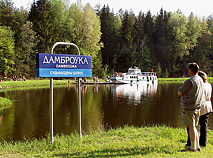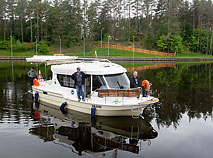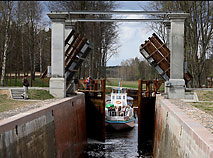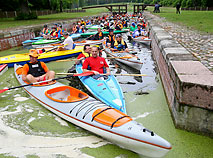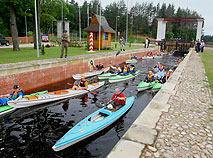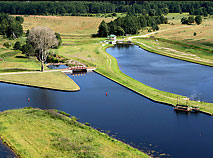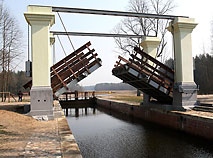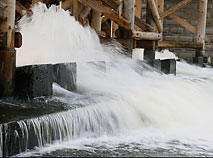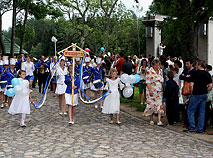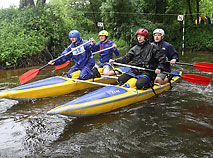Augustow Canal
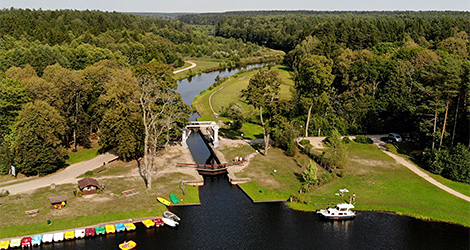
Augustow Canal is an outstanding hydraulic engineering installation of the 19th century, one of Europe’s largest canals, which has been included onto the preliminary UNESCO World Heritage List.
There are only three canals like this in the world: Caledonian Canal in the UK, Gota Canal in Sweden, and Augustow Canal, which is located in Poland and Belarus.
The waterway with the total length of 102km starts at Lake Serwy near Polish Augustow and stretches virtually to Belarusian Grodno. The artificial canals 45km long have connected 11 rivers (35km) and seven lakes (22km).
Augustow Canal history
Augustow Canal is truly a unique installation of its age judging by the complexity of engineering solutions, the scale, and certainly the beauty of the places it crosses.
In the 19th century this artificial waterway connected the basins of the Vistula River and the Neman River, enabling access to the Baltic Sea in the north and to the Black Sea in the south (via Oginski Canal, the Dnepr River, the Berezina River water system, and the Dvina River).
The idea to build the canal was born in the 1760-1770s in the age of King Stanislaw August Poniatowski. However, the construction began only in the 19th century after Prussia introduced high customs duties on cargo transportation to Baltic Sea ports.
The project was initiated by Finance Minister Franciszek Ksawery Drucki-Lubecki while army engineers led by Ignacy Pradzynski took care of designing the canal.
In 1824 the Augustow Canal project was approved by Emperor Aleksandr I. The construction took 15 years. As many as 29 flow-through dams were built in addition to 18 sluices, 21 chambers, 14 bridges, and 24 auxiliary facilities.
The canal stayed an important transport waterway for transporting wood and merchandise for a short time. In 1825 an agreement with Prussia took care of the problem of customs duties while the development of railroads in the second half of the 19th century trashed demand for the canal as a means of transportation.
However, since the canal is located in most picturesque places it has become a tourist attraction. The first hiking tour along the canal took place in 1909. Later on a horse-riding tour became available.
During World War One the canal was greatly damaged, partially due to the defense installations built in the late 19th – early 20th century.
In 1920-1939 the canal was reopened for travelers: two paddled steamers serviced the canal, kayaking tourism was popular, yacht clubs were opened, and the Festival of the Sea took place near the Dombrovka sluice. The first guidebook for Augustow Canal was published back then.
During the Great Patriotic War the hydraulic engineering installations of the canal, along which fortified emplacements had been built, suffered greatly while the bifurcation gate Chertok was completely destroyed.
Augustow Canal reconstruction
In 2004-2006 the Belarusian section (22km) of the canal was completely restored. Specialists restored the waterway, which had not been used since the 1950s, fixed washed-out and caved areas, ancient hydraulic engineering installations.
Many components – sluices and commemorative tablets bearing names of the designers, wooden columns, and draw bridges – were restored manually and now look authentic.
In 2005 the international seasonal Belarusian-Polish border checkpoint Lesnaya-Rudawka was opened for tourists on boats and kayaks. In 2017 it is supposed to be opened to hikers and bicyclists.
Augustow Canal at present
Nowadays the Belarusian part of the ancient canal has five regulator sluices, two dams, and four shipping sluices Nemnovo, Dombrovka, Volkushek, and Kuzhinets.
Augustow Canal’s largest sluice is the four-chamber sluice Nemnovo, which is 9.6m long. The water differential is nearly 10m, while sluicing takes about an hour.
Augustow Canal is an excellent place for active recreation, water, hiking and bicycle tourism. The picturesque places attract thousands of visitors.
The canal crosses the territory of the Belarusian landscape reserve Grodnenskaya Pushcha. It is one of the most environmentally pristine places of Belarus and the continent and a standard of plains in Central Europe.
In the center of the reserve is the Augustovskaya Pushcha, which is one of Europe’s largest forests located in Belarus, Poland, and Lithuania and contending for the status of a UNESCO transboundary biosphere reserve.
In the Belarusian land (10% of the forest) one can find about 800 varieties of plants, which is comparable to the Belovezhskaya Pushcha and the Berezinsky Biosphere Reserve. Some trees are 250-300 years old.
In 2011 a tourism and recreation park Avgustovsky Kanal as large as 5,750ha was created in the area adjacent to the famous waterway and the Neman River.
The place offers a lot to fans of active recreation:
-
tours on board of motor ships and on board of boats with and without sluicing;
-
catamaran ships and boats for rent;
-
kayaking (groups are made up in Grodno to go on a captivating tour along the canal);
-
hiking and bicycle tours (an eco-friendly cycling track is available along the canal);
-
well-furnished places for recreation, a caretaker house, and a compact hotel.
The motor ship Neman leaves the wharf near the sluice Dombrovka. Travelling with a group of tourists is more convenient since your travel agent will book the vessel in advance and will choose a route where you will be able to watch sluicing. On weekends tours are available on schedule and last for about an hour.
The canal and its tributaries offer over ten water routes. One of the longest ones is the water and bicycle riding route Augustow Canal – Belovezhskaya Pushcha (272.4km).
In 2014 after the last sluice on the Polish side was reconstructed a water route for powered yachts was made available Augustow – Grodno – Druskininkai.
The plan for developing the Avgustovsky Kanal Park envisages many interesting projects. In the near future tourists will be offered wharfs for small vessels, comfortable recreation zones and a GPS navigation map. Navigation pilot services are already available for those wishing to navigate the waterways safely.
The tourism complex Rynkovtsy (camping sites and parking lots, a stage and places for recreation) is under construction near the canal as well as the sport and recreation complex Peschany (a hotel, a recreation zone, a shooting range for archery).
Apart from that, special zones for recreation and swimming in summer will be made available on the banks of the canal.
Places of interest not far from Augustow Canal
Interesting specimens of history and architecture of Belarus can be found near Augustow Canal.
In the village of Nemnovo you can see an original house of the sluice caretaker built in 1830 using the Russian Empire style. The Augustow Canal Museum in the building of a former tavern offers visitors ancient maps of the area and schemes of the canal, handwritten documents, photos, and household articles of the 19th century.
In the town of Sopotskin you will be able to see 16th century town planning, the magnificent catholic church of the Assumption of the Virgin and Saint Iosif Kuntsevich, Neo-Gothic chapels and the oldest Jewish cemetery (dated by 1278). You will also be able to see Belarus’ only street named after Pope John Paul II.
Defensive pillboxes dating back to the Great Patriotic War (Molotov’s Line) and forts of the Grodno Fortress, which are on the list of Belarus’ historical and cultural legacy, are located along the canal.
The palace and park complex of the Volovich family in the village of Svyatsk has been built in accordance with the design by Italian Giuseppe de Sacco. The mysterious legend tells the story of the ghost of a daughter who has been walled up alive in a column of the palace by her father.
The magnificent mansion of the Drutsky-Gursky family, a park with valuable plants and a water system of the 19th century are key sights of the village of Radzivilki.
Not far from the canal you can see the popular farm tourism estate Garadzensky Mayontak Karobchytsy and the historical and cultural complex Partisan Camp.
Festivals and celebrations
Augustow Canal is located at the borders of Belarus, Poland, and Lithuania and became a venue for interesting cultural and sport events a long time ago.
The festival Augustow Canal in the Culture of Three Nations takes place near the sluice Dombrovka in August every year. It gathers original folk music collectives, musicians and masters, who represent their national arts.
If you attend the folk art festival Augustow Canal Invites Friends in May you will be able to get familiar with Belarusian culture, master crafts and sample dishes of the national cuisine.
Since the mid-1990s the canal has been used every year to host kayaking and catamaraning competitions under the title of Neman Spring in April. The international cycling marathon Neighbors takes place along the banks of the canal in July. It gathers participants from Belarus, Poland, and Lithuania.
How to get to Augustow Canal
You can get to Augustow Canal from Grodno by car or by bus using the bus lines Grodno-Nemnovo, Grodno-Goryachki, Grodno-Kalety (the stops Sonichi or Avgustovsky Kanal). It is convenient to travel as part of an excursion group.
From Minsk you can reach the canal by car after consulting the map and going in the direction of Volozhin-Lida-Skidel. The distance from Minsk to Augustow Canal is 327km.
Tourists can stay in Grodno hotels or in farm tourism estates near the canal.


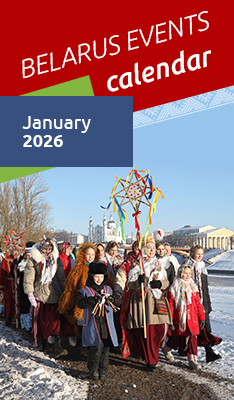




 print version
print version make home page
make home page add to bookmarks
add to bookmarks